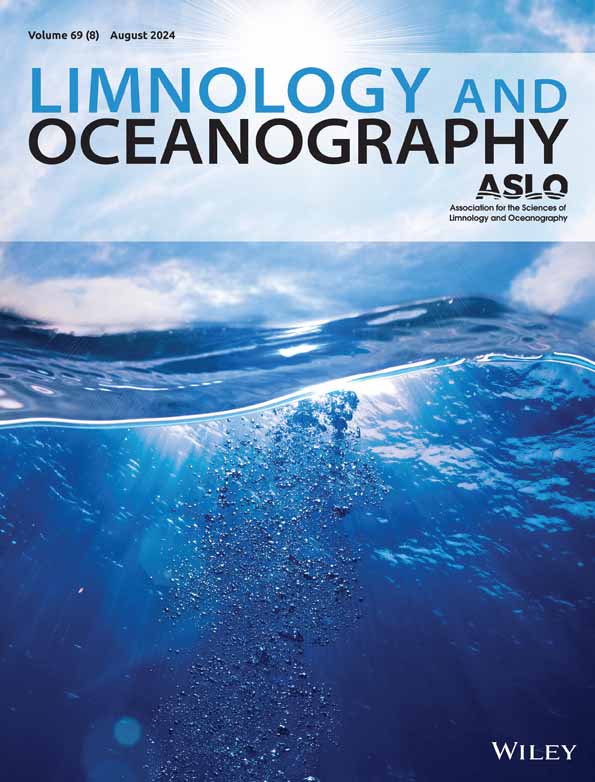Climate change–induced terrestrial matter runoff may decrease food web production in coastal ecosystems
IF 3.8
1区 地球科学
Q1 LIMNOLOGY
引用次数: 0
Abstract
Climate change is projected to cause elevated precipitation in northern Europe, leading to increased runoff of terrestrial matter to coastal areas. The consequences for food web production and ecosystem function remain unclear. A mesocosm experiment was performed to investigate the impacts of elevated terrestrial matter input, using a natural plankton community from the northern Baltic Sea with added young‐of‐the‐year perch as planktivorous top consumer. Addition of terrestrial matter caused water browning and increased dissolved organic carbon and inorganic nutrient concentrations. Phytoplankton primary production showed a negative response to terrestrial matter due to decreased light availability, while heterotrophic bacterial production increased. The trophic balance, calculated as the difference between primary production and heterotrophic bacterial production, indicated that net‐heterotrophy was triggered by terrestrial matter enrichment. Primary production was identified as the main basal energy source for fish. Addition of terrestrial matter reduced the food web efficiency, calculated as the ratio between fish production and basal production (primary production + heterotrophic bacterial production). Furthermore, stable isotope analysis of seston and fish indicated that the added terrestrial matter was not efficiently incorporated in the food web and only marginally altered the food web trophic positions. The results suggest that the main food chain consisted of phytoplankton, mesozooplankton, and fish, and that the ecosystem production was overall light driven. Under a changing climate, several negative effects can be expected, including a poorer light climate, reduced ecosystem production and net‐heterotrophy. These alterations have potentially significant consequences for ecosystem functioning, fish production, and thus ecosystem services.气候变化引起的陆地物质径流可能会减少沿海生态系统的食物网产量
气候变化预计将导致北欧降水增加,导致陆地物质流向沿海地区的径流增加。对食物网生产和生态系统功能的影响尚不清楚。为了研究陆源物质输入增加的影响,我们进行了一项中生态实验,研究对象是波罗的海北部的一个天然浮游生物群落,其中添加了幼年鲈鱼作为浮游生物的主要食用者。陆源物质的加入使水体褐变,溶解有机碳和无机养分浓度增加。由于光能利用率降低,浮游植物初级产量对陆源物质呈负响应,而异养细菌产量增加。根据原生产量和异养细菌产量之间的差异计算的营养平衡表明,净异养是由陆源物质富集引发的。初级生产被确定为鱼类的主要基础能量来源。陆源物质的添加降低了食物网效率,以鱼类产量与基础产量(初级产量+异养细菌产量)之比计算。此外,杉木和鱼类的稳定同位素分析表明,增加的陆源物质没有有效地融入食物网,只是轻微地改变了食物网的营养位置。结果表明,主要的食物链由浮游植物、中浮游动物和鱼类组成,生态系统生产总体上是光驱动的。在气候变化的情况下,预计会产生一些负面影响,包括气候变弱、生态系统产量减少和净异养。这些变化对生态系统功能、鱼类生产以及生态系统服务具有潜在的重大影响。
本文章由计算机程序翻译,如有差异,请以英文原文为准。
求助全文
约1分钟内获得全文
求助全文
来源期刊

Limnology and Oceanography
地学-海洋学
CiteScore
8.80
自引率
6.70%
发文量
254
审稿时长
3 months
期刊介绍:
Limnology and Oceanography (L&O; print ISSN 0024-3590, online ISSN 1939-5590) publishes original articles, including scholarly reviews, about all aspects of limnology and oceanography. The journal''s unifying theme is the understanding of aquatic systems. Submissions are judged on the originality of their data, interpretations, and ideas, and on the degree to which they can be generalized beyond the particular aquatic system examined. Laboratory and modeling studies must demonstrate relevance to field environments; typically this means that they are bolstered by substantial "real-world" data. Few purely theoretical or purely empirical papers are accepted for review.
 求助内容:
求助内容: 应助结果提醒方式:
应助结果提醒方式:


